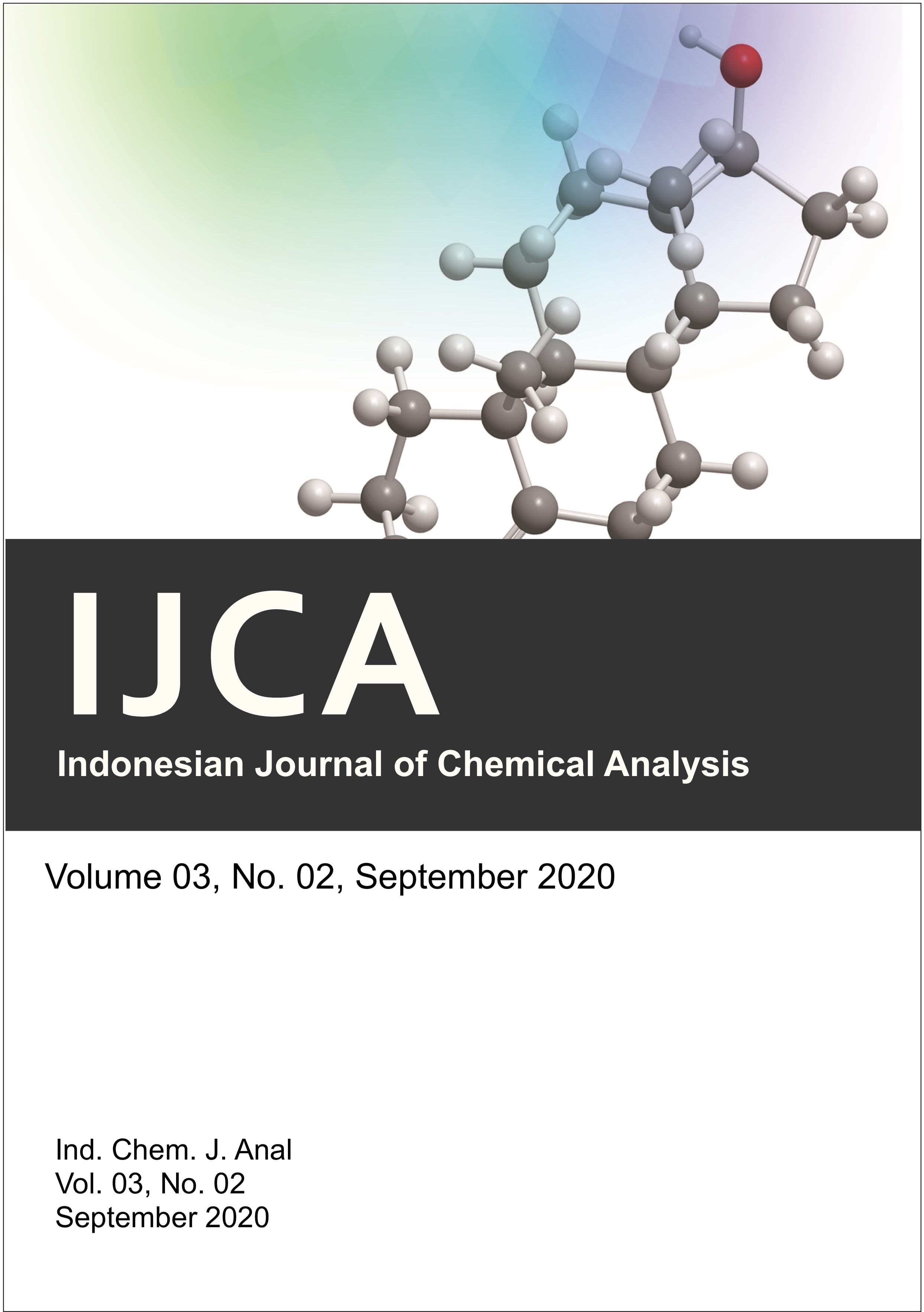Main Article Content
Abstract
Article Details
Copyright (c) 2020 Indonesian Journal of Chemical Analysis (IJCA)

This work is licensed under a Creative Commons Attribution-ShareAlike 4.0 International License.
You are free to:
Share — copy and redistribute the material in any medium or format
Adapt — remix, transform, and build upon the material for any purpose, even commercially
Under the following terms:
Attribution — You must give appropriate credit, provide a link to the license, and indicate if changes were made. You may do so in any reasonable manner, but not in any way that suggests the licensor endorses you or your use.
ShareAlike — If you remix, transform, or build upon the material, you must distribute your contributions under the same license as the original
No additional restrictions — You may not apply legal terms or technological measures that legally restrict others from doing anything the license permits
References
- Keteren, S. 1986. Minyak dan Lemak Pangan. Penerbit UI Press, Jakarta
- Rinto. P, Siti N dan Akhirudin , M. 2018. Mikrostruktur Arang Aktif Batok Kelapa untuk Pemurnian Minyak Goreng Habis Pakai, Jurnal Keteknikan Pertanian Vol 6 (1) : 69-74
- Keteren, S. 1986. Minyak dan Lemak Pangan. Penerbit UI Press, Jakarta
- Alexander, J., Shirton, dkk, 1951., Bailey’s Industries oil and fat product, 3rd edition john Willey & Sons New York, London, Sidney
- Ningrum. 2013. Pemanfaatan Minyak Goreng Bekas dan abu kulit buah randu sebagai bahan pembuatan sabun mandi organik berbasis teknologi ramah lingkungan. Jurnal teknologi kimia dan industry Vol 2.No. 2 pp 27
- Astutik, 2010. Pengaruh Suhu Interaksi minyak goreng bekas dengan menggunakan karbon aktif biji kelor terhadap angka iodin dan angka peroksida. Malang: UIN Maulana Malik Ibrahim
- Zulfa, K, Agung, S, W dan Rusdin, R, 2019, Angka Asam dan Peroksida Minyak Jelantah dari Penggorengan Lele Secara Berulang, Jurnal Kesehatan, Vol 12 (2) : 81-96
- Ambar, Rukmini, 2007, Regenerasi Minyak Goreng Bekas dengan Arang Aktif Sekam Menekan Kerusakan Organ Tubuh, Yogyakarta: Seminar Nasional Teknologi Univ Widya Darma Yogyakarta
- Widayat dkk, 2005, Optimasi Proses Adsobrsi Minyak Goreng Bekas dengan Adsroben zeolite Alam, Semarang : Teknik Kimia
- Widayat dkk, 2005, Optimasi Proses Adsobrsi Minyak Goreng Bekas dengan Adsroben zeolite Alam, Semarang : Teknik Kimia
- Ambar, Rukmini, 2007, Regenerasi Minyak Goreng Bekas dengan Arang Aktif Sekam Menekan Kerusakan Organ Tubuh, Yogyakarta: Seminar Nasional Teknologi Univ Widya Darma Yogyakarta
- Pujowati, 1996, Efektifitas Waktu Kontak Karbon Aktif Tempurung Kelapa Dalam Penurunan Kadar H2S Terlarut Pada Air Limbah Industri Penyamakan Kulit,Semarang
- Ria, Wijayanti, 2009, Arang Aktif dari Ampas Tebu Sebagai Adsorben Pada Pemurnian Minyak Goreng Bekas, Bogor: Kimia ITB
References
Keteren, S. 1986. Minyak dan Lemak Pangan. Penerbit UI Press, Jakarta
Rinto. P, Siti N dan Akhirudin , M. 2018. Mikrostruktur Arang Aktif Batok Kelapa untuk Pemurnian Minyak Goreng Habis Pakai, Jurnal Keteknikan Pertanian Vol 6 (1) : 69-74
Keteren, S. 1986. Minyak dan Lemak Pangan. Penerbit UI Press, Jakarta
Alexander, J., Shirton, dkk, 1951., Bailey’s Industries oil and fat product, 3rd edition john Willey & Sons New York, London, Sidney
Ningrum. 2013. Pemanfaatan Minyak Goreng Bekas dan abu kulit buah randu sebagai bahan pembuatan sabun mandi organik berbasis teknologi ramah lingkungan. Jurnal teknologi kimia dan industry Vol 2.No. 2 pp 27
Astutik, 2010. Pengaruh Suhu Interaksi minyak goreng bekas dengan menggunakan karbon aktif biji kelor terhadap angka iodin dan angka peroksida. Malang: UIN Maulana Malik Ibrahim
Zulfa, K, Agung, S, W dan Rusdin, R, 2019, Angka Asam dan Peroksida Minyak Jelantah dari Penggorengan Lele Secara Berulang, Jurnal Kesehatan, Vol 12 (2) : 81-96
Ambar, Rukmini, 2007, Regenerasi Minyak Goreng Bekas dengan Arang Aktif Sekam Menekan Kerusakan Organ Tubuh, Yogyakarta: Seminar Nasional Teknologi Univ Widya Darma Yogyakarta
Widayat dkk, 2005, Optimasi Proses Adsobrsi Minyak Goreng Bekas dengan Adsroben zeolite Alam, Semarang : Teknik Kimia
Widayat dkk, 2005, Optimasi Proses Adsobrsi Minyak Goreng Bekas dengan Adsroben zeolite Alam, Semarang : Teknik Kimia
Ambar, Rukmini, 2007, Regenerasi Minyak Goreng Bekas dengan Arang Aktif Sekam Menekan Kerusakan Organ Tubuh, Yogyakarta: Seminar Nasional Teknologi Univ Widya Darma Yogyakarta
Pujowati, 1996, Efektifitas Waktu Kontak Karbon Aktif Tempurung Kelapa Dalam Penurunan Kadar H2S Terlarut Pada Air Limbah Industri Penyamakan Kulit,Semarang
Ria, Wijayanti, 2009, Arang Aktif dari Ampas Tebu Sebagai Adsorben Pada Pemurnian Minyak Goreng Bekas, Bogor: Kimia ITB




